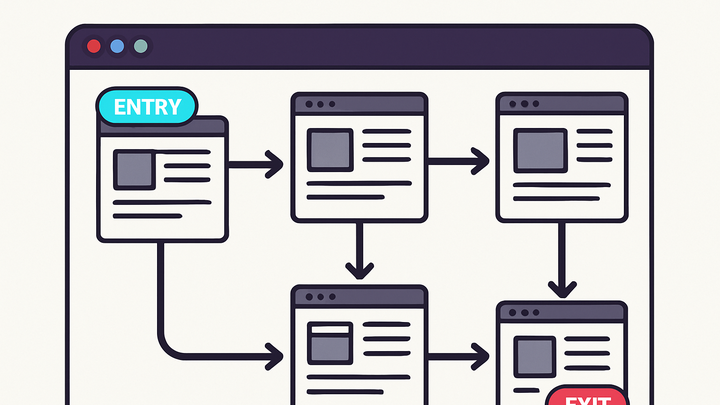Published on 2025-06-22T02:13:48Z
What is Click Path? Examples of Click Path Analysis
Click Path refers to the ordered sequence of clicks or interactions a user makes on a website or app during a session. Analyzing click paths helps businesses and analysts understand navigation behaviors, identify friction points, and optimize conversion funnels. By mapping each pageview and event in sequence, teams can visualize how visitors move from entry to goal pages. Tools like PlainSignal (cookie-free simple analytics) and Google Analytics 4 (GA4) offer click path tracking features—PlainSignal via its lightweight script and GA4 via its path exploration reports. Implementing click path analysis involves embedding a tracking snippet (e.g.:
<link rel="preconnect" href="//eu.plainsignal.com/" crossorigin />
<script defer data-do="yourwebsitedomain.com" data-id="0GQV1xmtzQQ" data-api="//eu.plainsignal.com" src="//cdn.plainsignal.com/plainsignal-min.js"></script>
) or enabling enhanced measurement in GA4.
By studying click paths, teams can refine site architecture, streamline user journeys, and ultimately boost engagement and conversions.
Click path
A click path traces the sequence of user interactions across a site, revealing navigation patterns and conversion opportunities.
Why Click Path Matters
Understanding click paths provides direct insights into user behavior, revealing how visitors navigate your site, where they encounter obstacles, and which paths drive conversions. This section explores why tracking click paths is crucial for UX design, marketing optimization, and data-driven decision making.
-
Behavior insights
Click paths uncover the common routes users take to find information or complete tasks, helping identify popular content and navigation trends.
-
Conversion optimization
Analyzing sequences that lead to purchases or sign-ups highlights effective pathways and pinpoints drop-off stages in the funnel.
-
Usability improvements
Identifying loops or unexpected back-and-forth clicks helps reveal confusing layouts or broken links that hinder smooth navigation.
Components of a Click Path
A click path consists of multiple elements, including pageviews, events, timestamps, and user sessions. Breaking down these components clarifies what data is collected and how it forms a coherent path for analysis.
-
Pageviews and screens
Each visited page or screen is recorded in the order viewed. Entry pages mark the start of a session, while exit pages indicate where users leave.
-
Entry page
The first page a user lands on, often influenced by marketing channels or search queries.
-
Exit page
The last page before a user leaves, indicating potential friction or satisfaction points.
-
-
Events and actions
Clicks on buttons, links, form submissions, and other interactive events capture user intent beyond mere page navigation.
-
Sequence and timing
Timestamps attached to each event reveal the time users spend between interactions, highlighting engagement levels or hesitation points.
Tracking Click Paths with SaaS Tools
Implementing click path tracking varies between analytics platforms. This section compares the setup in PlainSignal and GA4, showcasing code snippets and configuration steps.
-
Using PlainSignal
Add the PlainSignal script to your site’s
<head>section to enable cookie-free click path tracking. Example:<link rel="preconnect" href="//eu.plainsignal.com/" crossorigin /> <script defer data-do="yourwebsitedomain.com" data-id="0GQV1xmtzQQ" data-api="//eu.plainsignal.com" src="//cdn.plainsignal.com/plainsignal-min.js"></script> -
Setting up in GA4
Enable Enhanced Measurement in GA4 to automatically track pageviews and outbound clicks. Use the Path Exploration report under “Explore” to visualize click sequences.
-
Comparing data models
PlainSignal uses a privacy-first, aggregate approach without cookies, while GA4 relies on an event-based model with user-centric identifiers for deeper user journey analysis.
Analyzing and Interpreting Click Path Reports
Once data is collected, interpreting click path reports reveals actionable insights. Learn how to use built-in reports and custom explorations to spot trends and issues.
-
Path exploration in GA4
Access the Path Exploration report in GA4’s Explore section to map out user journeys, set start/end points, and filter by segments.
-
Custom dashboards in PlainSignal
PlainSignal’s simple UI allows filtering sessions by date, path length, or events, making it easy to isolate specific navigation patterns.
-
Identifying bottlenecks
Look for pages with high drop-off rates or loops in navigation sequences to identify friction points that need UX optimization.
Best Practices and Use Cases
Effective click path analysis requires clear goals and strategic segmentation. This section outlines best practices and common scenarios where click paths drive business value.
-
Define clear goals
Establish specific objectives—such as increasing sign-ups or reducing cart abandonment—to focus your analysis on relevant user journeys.
-
Segment your audience
Compare click paths for different user segments (e.g., new vs. returning visitors) to tailor experiences and marketing strategies.
-
Combine with other metrics
Augment click path insights with heatmaps, session recordings, and conversion funnels for a holistic view of user experience.
-
Continuous monitoring
Regularly review click paths to detect UX regressions after site updates or marketing campaigns.
